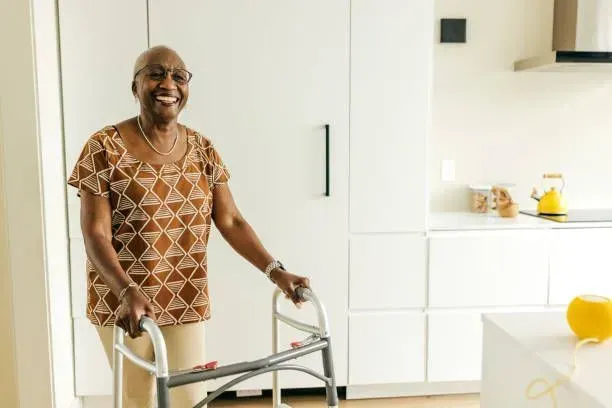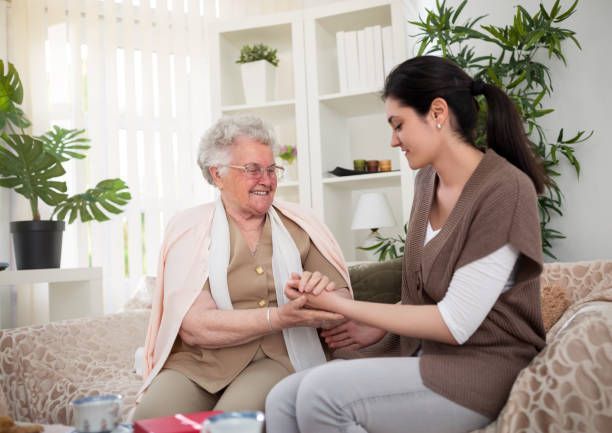8 Ideas to Motivate an Aging Parent to Use a Cane or Walker
Consider the following from the Harvard Medical School Affiliate - Hebrew Senior Life "Mobility is key to maintaining independence and one of the greatest threats to mobility in older adults is a fall. Each year, millions of older people—those 65 and older—fall. More than one out of four older people falls each year (but less than half tell their doctor). Falling once doubles your chances of falling again.
One in five falls causes a serious injury such as broken bones or a head injury.
The psychological and functional consequences of falls can also be severe whether or not an injury occurs. Feeling unsteady or an actual fall can lead to fear of falling and anxiety about normal activities on the part of the older person at risk, as well as among family members and caregivers. In response the older person may limit their activity, which decreases mobility, and increases dependence on others."

As our loved ones gracefully navigate the golden years, ensuring their safety and well-being becomes paramount. The concern for an aging parent's stability and mobility is natural, and introducing the idea of using a cane or walker may be met with resistance. However, this journey is about empowering them to maintain their independence and freedom. In this guide, we explore thoughtful and compassionate ways to initiate conversations about embracing mobility aids, specifically canes and walkers. By approaching this topic with care, understanding, and a focus on enhancing their quality of life, you can pave the way for a safer and more confident future for your aging parent. If you find yourself wondering how to broach the subject of using a cane or walker with your aging parent, consider these gentle approaches to ensure their safety and well-being.
8 Ideas to Motivate an Aging Parent to Use a Cane or Walker
- Initiate an Open Conversation: Initiating an open conversation with an aging parent about using a walker or cane requires a delicate and empathetic approach. Begin by expressing genuine concern for their well-being and safety, emphasizing that your primary goal is to support their continued independence. Use "I" statements to convey your observations, such as, "I've noticed that you've been a bit unsteady on your feet, and it worries me." This approach avoids sounding accusatory and instead focuses on shared concern. Acknowledge their autonomy and express that the discussion is rooted in care and a desire to enhance their stability. Reassure them that utilizing a walker or cane is a proactive step toward preventing potential accidents and maintaining their freedom. Encourage an open dialogue by asking for their thoughts and feelings on the matter, creating a supportive space for them to express any concerns or reservations.
- Highlight the Benefits: When communicating with an aging parent about the use of a walker or cane, it's crucial to highlight the myriad benefits that these mobility aids can bring to their daily life. Emphasize that these tools are not just about stability but are powerful enablers of safety and independence. By incorporating a walker or cane into their routine, they gain enhanced stability, significantly reducing the risk of falls and accidents. Reinforce the idea that these aids are not symbols of limitation but rather tools that empower them to navigate their surroundings confidently. Point out the increased freedom and ability to move around without the fear of instability, contributing to an overall improvement in their quality of life. By focusing on the positive impact on their well-being, you help them envision these mobility aids as valuable companions in their journey toward maintaining independence.
- Frame it as a Tool, Not a Hindrance: When broaching the topic of using a walker or cane with an aging parent, it's essential to frame these mobility aids as valuable tools rather than perceived hindrances. Emphasize that these aids are specifically designed to enhance their daily life by providing support and stability. Position the walker or cane as a proactive measure, a tool that facilitates movement and independence rather than something that restricts. Highlight how these aids empower them to navigate their environment safely and with confidence. By reframing the conversation, you shift the focus from limitations to capabilities, encouraging your aging parent to view the walker or cane as a positive addition that allows them to maintain an active and fulfilling lifestyle.
- Choose the Right Device: When engaging in a conversation with an aging parent about the use of a walker or cane, stressing the significance of choosing the right device is paramount. Highlight the variety of stylish, ergonomic, and personalized options available, emphasizing that selecting the appropriate mobility aid is an individualized process. Encourage them to actively participate in this decision-making, considering factors such as comfort, ease of use, and personal preferences. By involving them in the selection process, you ensure that the chosen walker or cane aligns seamlessly with their lifestyle, fostering a sense of ownership and acceptance. The right device becomes not only a practical tool for stability and safety but also a tailored companion that complements their unique needs and preferences, ultimately contributing to a positive and empowering experience.
- Share Success Stories: When discussing the use of a walker or cane with an aging parent, incorporating success stories can be a powerful motivator. Share uplifting anecdotes of individuals who have embraced these mobility aids and experienced remarkable improvements in their daily lives. Illustrate how adopting a walker or cane positively impacted their stability, confidence, and overall well-being. These success stories serve as tangible examples, demonstrating that many have navigated similar concerns and emerged with enhanced mobility and independence. By showcasing real-life instances of triumph, you provide your aging parent with reassurance and inspiration, helping them envision the potential benefits and positive outcomes that can accompany the use of a walker or cane in their own journey.
- Accompany Them to Healthcare Appointments: Accompanying your aging parent to healthcare appointments can be a strategic and supportive way to broach the topic of using a walker or cane. By involving a healthcare professional in the conversation, you provide an objective perspective on the importance of these mobility aids for safety and well-being. During the appointment, express any concerns you may have noticed and inquire about the doctor's recommendations regarding mobility support. Having a healthcare advocate can lend credibility to the discussion, as they can emphasize the benefits of using a walker or cane in maintaining balance and preventing potential accidents. This collaborative approach not only ensures that your parent's health is prioritized but also positions the conversation within the context of professional advice, making it more likely for your aging parent to consider and accept the use of a walker or cane as a proactive step toward their safety.
- Demonstrate Use: To effectively communicate the benefits of using a walker or cane to an aging parent, consider providing a hands-on demonstration. Actions often speak louder than words, and physically showcasing how these mobility aids can enhance stability and confidence can be impactful. Take the time to demonstrate the proper usage, highlighting the support and balance they provide. Encourage your parent to try it themselves under your guidance, emphasizing the ease and practicality of incorporating a walker or cane into their daily routine. This tangible experience allows them to witness firsthand the added security and independence these devices offer. By demystifying the process through a hands-on demonstration, you make the idea of using a walker or cane more tangible and less intimidating, paving the way for a more open and receptive conversation about their potential benefits.
- Address Concerns: When engaging in a conversation with an aging parent about the use of a walker or cane, the role of being a great listener is paramount. Begin by expressing empathy and a genuine interest in understanding their perspective. Allow them to share their thoughts, feelings, and any concerns they may have about incorporating a mobility aid into their daily life. Listen actively without interrupting, acknowledging their fears or reservations. Once they've shared their concerns, address each one with compassion and provide reassurance. By validating their feelings and actively addressing their worries, you create a space for open communication and collaboration. This approach fosters trust and allows your aging parent to feel heard and understood, increasing the likelihood of a positive response to the idea of using a walker or cane for improved stability, safety, and independence.
Remember, the goal is to prioritize their safety and enhance their quality of life. By approaching the conversation with empathy, understanding, and a focus on independence, you can guide your aging parent toward embracing the benefits of mobility aids.
The Risks and Consequences of Not Using a Cane or Walker to Self and Others
The risks and consequences of not using a cane or walker for an aging parent extend beyond their personal safety, encompassing potential hazards for both themselves and those around them. Without the support of a mobility aid, an aging parent may face an increased risk of falls, which can lead to serious injuries such as fractures or head trauma. Additionally, their unsteadiness could pose a risk to others, especially in crowded or confined spaces. By using a cane or walker, they not only safeguard their own stability but also contribute to a safer environment for those sharing the space. Neglecting the use of these mobility aids not only jeopardizes the well-being of the aging parent but also heightens the likelihood of accidents that could impact the safety of others in their vicinity. Incorporating a walker or cane becomes not just a personal choice but a responsibility that extends to the broader community, fostering a secure and protected environment for everyone involved.
In the tapestry of aging, the decision to introduce a cane or walker to a loved one's life is a delicate but crucial thread. At 7 Day Home Care, we understand the importance of preserving independence while prioritizing safety. Our commitment extends beyond providing exemplary and affordable home health care services in Manhattan, Queens, Brooklyn, Nassau County, and Suffolk County, New York. We believe in fostering conversations that empower families to make choices that enhance their loved ones' lives. By embracing mobility aids with compassion and sensitivity, we pave the way for a future where safety and independence harmoniously coexist. If you require assistance in this journey, our dedicated team is here to support you with nursing assessments, personalized care plans, and highly experienced home health aides adept at assisting with activities of daily living, including transferring and ambulation. Let's weave a story of enhanced well-being and continued independence together. Please contact 7 Day Home Care at 516-408-0034 to learn more about our home care services and how you or your loved one can benefit from our award winning home health care services.
Brian Callahan
7 Day Home Care










